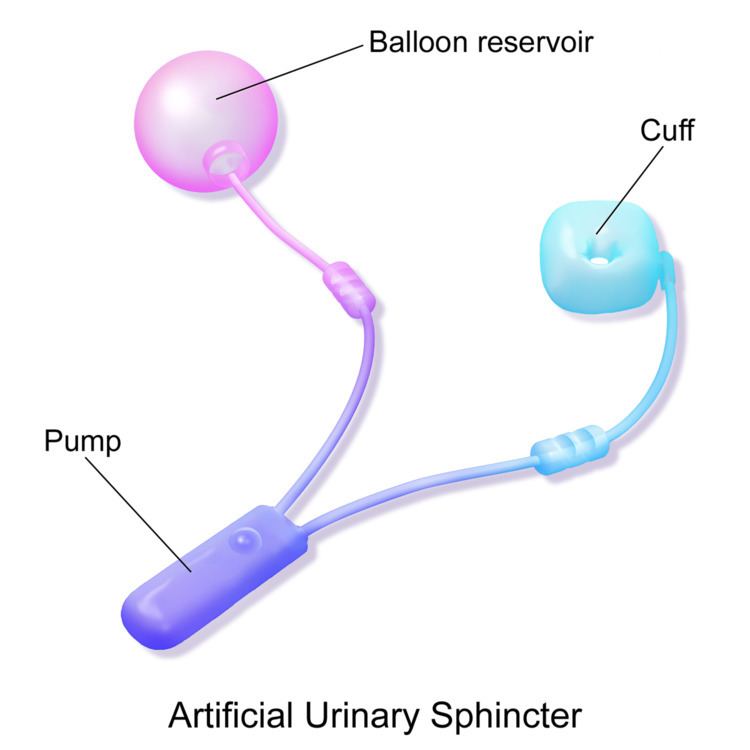 | ||
Similar Pelvic organ prolapse, Stress incontinence, Urinary incontinence | ||
An artificial urinary sphincter (AUS) is an implanted device to treat moderate to severe stress urinary incontinence, most commonly in men. The AUS is designed to supplement the function of the natural urinary sphincter that restricts urine flow out of the bladder.
Contents
Description
Although models vary, the common thread among currently available designs is a mechanical constriction mechanism placed around the urethra, and an externally accessible control mechanism allowing the user to relieve the constriction to allow urination.
About the Artificial urinary Sphincter Device
Artificial urinary sphincter surgeries have been performed since being first introduced in the early 1970's. The most commonly used device is the AMS 800 (Boston Scientific, Marlborough, MA) (shown on right), in which there is a cuff around the urethra, a pump that is placed in the scrotum and an abdominal reservoir.[1] There is fluid inside the system that is used to generate pressure and compress the urethra (to prevent urine from leaking). The urethral cuff is deflated manually by pressing the control pump that is placed in the scrotum, allowing the patient to empty their bladder. The urethral cuff then re-inflates automatically to refill the urethral cuff and once again prevent urine from leaking.[1]
Success Rates
Numerous studies have been published regarding outcomes of patients that undergo artificial urinary sphincter placement. In the largest available series, evaluating 1082 patients that underwent AUS placement at Mayo Clinic (Rochester, MN) the 5-year device survival was 74%. Similar results have been reported by others, with 5-year survival rates ranging from 59% to 79%. Along with this, surveys of patients that underwent the procedure have found that over 90% would recommend the procedure to a family member or friend.
Notably, in all series, over time some patients needed to undergo a repeat surgery for recurrent Urinary incontinence or device infection. In a pooled analysis of the available studies the re-intervention rate (for any cause) was roughly 26%. Importantly, some studies have demonstrated that surgeons who perform this procedure more frequently (high-volume surgeons) have improved outcomes compared to those who do them less frequently. In fact, in this series the reoperative rates decreased by roughly 50% as surgeons reached their 200th case emphasizing the need for potential patients to seek high volume surgeons to improve their chance of success.
Risks
Possible risks arising from the implantation of the AUS include:
Ongoing Cares
As noted above, there is a risk that urinary incontinence returns after AUS placement, in that instance some patients undergo revision surgeries to replace/repair the device and improve their leakage of urine.
For those that have had an AUS placed it is important that they inform their providers prior to any attempt at urethral catheter placement, in an attempt to minimize the risk of damage to their AUS.
Manufacturers
AUS devices include:
